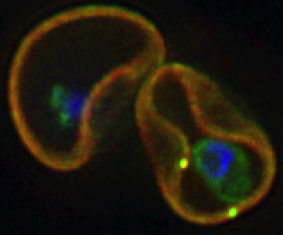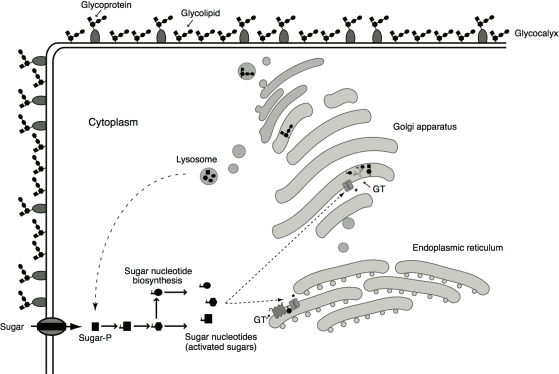 Glycans are crucial for parasite virulence and survival. We have described the biosynthesis of glycosylation precursors at different stages of the parasite cycle, outlining their biological function. Now our aim is to take advantage of this knowledge to identify novel ways to fight malaria.
Glycans are crucial for parasite virulence and survival. We have described the biosynthesis of glycosylation precursors at different stages of the parasite cycle, outlining their biological function. Now our aim is to take advantage of this knowledge to identify novel ways to fight malaria.
Main projects
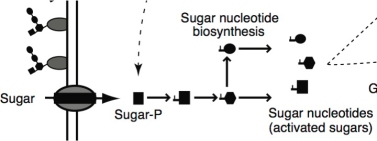 The Hexosamine Biosynthetic Pathway (HBP) – The HBP is essential for making key glycoconjugates like GPI-anchors. An important step of this pathway is the enzyme GNA1, which adds an acetyl group to glucosamine-6-P. We identified a distinct group of these enzymes, called ApiGNA1, unique to Apicomplexa parasites. ApiGNA1 evolved separately from other eukaryotes, presenting a potential target for new anti-parasitic drugs, exploiting its distinct features for selective inhibition.
The Hexosamine Biosynthetic Pathway (HBP) – The HBP is essential for making key glycoconjugates like GPI-anchors. An important step of this pathway is the enzyme GNA1, which adds an acetyl group to glucosamine-6-P. We identified a distinct group of these enzymes, called ApiGNA1, unique to Apicomplexa parasites. ApiGNA1 evolved separately from other eukaryotes, presenting a potential target for new anti-parasitic drugs, exploiting its distinct features for selective inhibition.
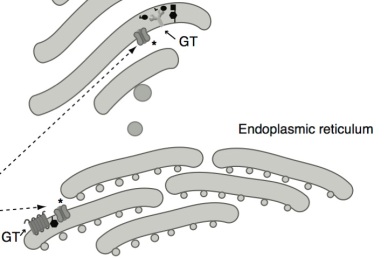 Protein N-glycosylation in P. falciparum endoplasmic reticulum (ER) – The end product of the HBP, UDP-GlcNAc, is key for protein N-glycosylation in the ER. N-glycosylation is critical for protein folding and trafficking in eukaryotes. Tunicamycin, a specific N-glycosylation blocker, halts parasite growth in the second growth cycle after treatment. This ‘delayed death’ phenotype resembles that caused by inhibitors of the apicoplast, a relic organelle in P. falciparum needed for lipid and isoprenoid biosynthesis. Hence, whereas our results confirm the relevance of N-glycosylation for parasite growth, they pose new interesting questions regarding its biological role in P. falciparum. Thorough exploration of these pathways may uncover previously unknown aspects of the biology of the malaria parasite.
Protein N-glycosylation in P. falciparum endoplasmic reticulum (ER) – The end product of the HBP, UDP-GlcNAc, is key for protein N-glycosylation in the ER. N-glycosylation is critical for protein folding and trafficking in eukaryotes. Tunicamycin, a specific N-glycosylation blocker, halts parasite growth in the second growth cycle after treatment. This ‘delayed death’ phenotype resembles that caused by inhibitors of the apicoplast, a relic organelle in P. falciparum needed for lipid and isoprenoid biosynthesis. Hence, whereas our results confirm the relevance of N-glycosylation for parasite growth, they pose new interesting questions regarding its biological role in P. falciparum. Thorough exploration of these pathways may uncover previously unknown aspects of the biology of the malaria parasite.
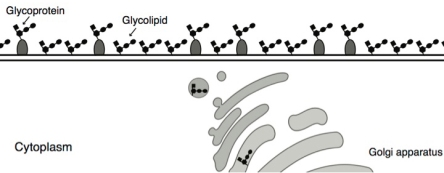 The biosynthesis of glycosylphosphatidylinositol (GPI) – In the malaria parasite, the most prominent glycosylation involves the attachment of GPI to certain proteins, anchoring them into lipid bilayers. P. falciparum relies on over 30 GPI-anchored proteins for survival. Free GPI glycolipids also exacerbate the severity of malaria. Despite its importance, the GPI biosynthetic pathway is underexplored in P. falciparum. Recent findings validate it as a target for anti-malarial compounds. Thus further research is warranted to unveil its relevance across the parasite life cycle.
The biosynthesis of glycosylphosphatidylinositol (GPI) – In the malaria parasite, the most prominent glycosylation involves the attachment of GPI to certain proteins, anchoring them into lipid bilayers. P. falciparum relies on over 30 GPI-anchored proteins for survival. Free GPI glycolipids also exacerbate the severity of malaria. Despite its importance, the GPI biosynthetic pathway is underexplored in P. falciparum. Recent findings validate it as a target for anti-malarial compounds. Thus further research is warranted to unveil its relevance across the parasite life cycle.
Funding & Support

